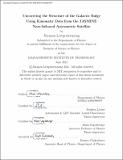Uncovering the Structure of the Galactic Bulge Using Kinematic Data from the JASMINE Near-Infrared Astrometric Satellite
Author(s)
Lertprasertpong, Jitrapon
DownloadThesis PDF (213.7Kb)
Additional downloads
Advisor
Levine, Stephen
Vogelsberger, Mark
Terms of use
Metadata
Show full item recordAbstract
The Galactic Center (GC) is the region with the most extreme stellar densities, a strong gravitational field, and the most prolific star formation region in the Milky Way. Furthermore, the Milky Way is the only galaxy that we can resolve individual structure such as Nuclear Stellar Disk (NSD) and Nuclear Bulge (NB) from the whole bulge structure. These reasons make the observation of the Galactic Center appealing to astronomers. Due to the high extinction from interstellar dust in the visible band (Aᵥ ≈ 30 mag), it is necessary to study the Galactic Bulge in the Near-Infrared (NIR) band. JASMINE mission is designed to observe the Galactic Nuclear Bulge at the region of 100-300 parsecs from the Galactic Center in the Near-Infrared band. In this thesis, we evaluate the capability of the JASMINE satellite in studying the galactic bulge structure in several aspects, including the JASMINE’s capability to distinguish gravitational potential models at the Galactic Bulge, possible uncertainties in JASMINE parallax and proper motion measurements, and the population of stars that JASMINE can observe. The result of this study indicates that JASMINE can distinguish two limiting cases of mass distribution: point mass, and homogeneous sphere within the proper motion accuracy in the order of 10 mas/year. In addition, we also notice that the accuracy of 25 µas for parallax measurement would result in the probability of 45% to mistake bulge star as disk stars. Finally, we also conclude that the sample population of stars suitable for JASMINE are Giants with a sample size of approximately 2.6 x 10⁵ stars.
Date issued
2021-06Department
Massachusetts Institute of Technology. Department of PhysicsPublisher
Massachusetts Institute of Technology